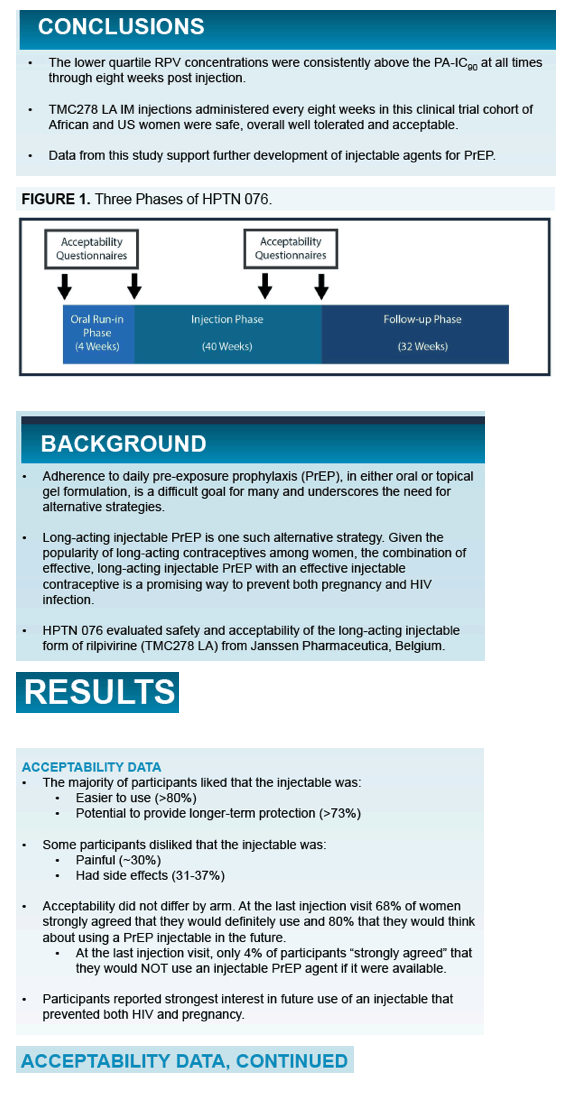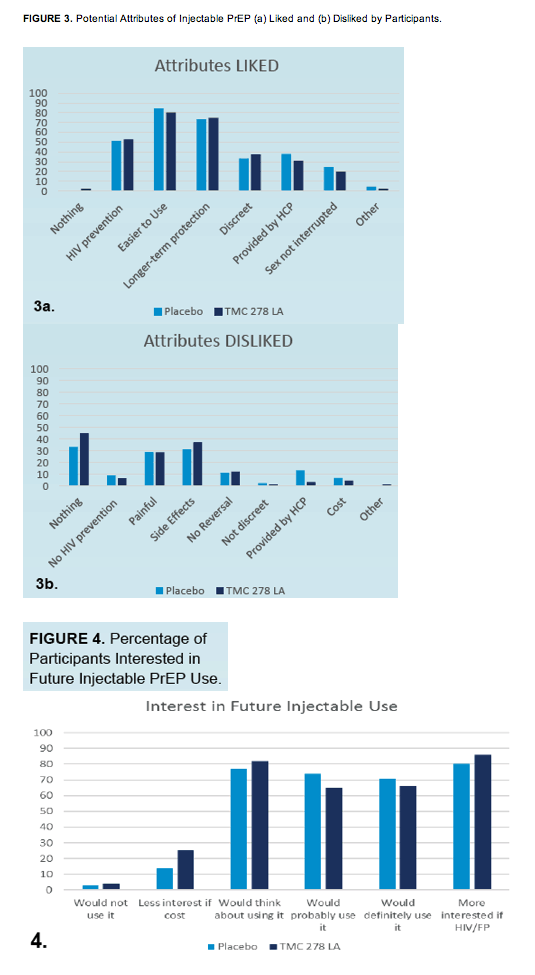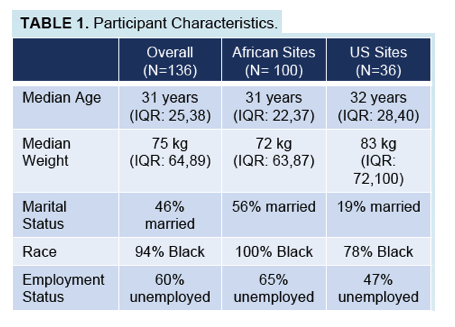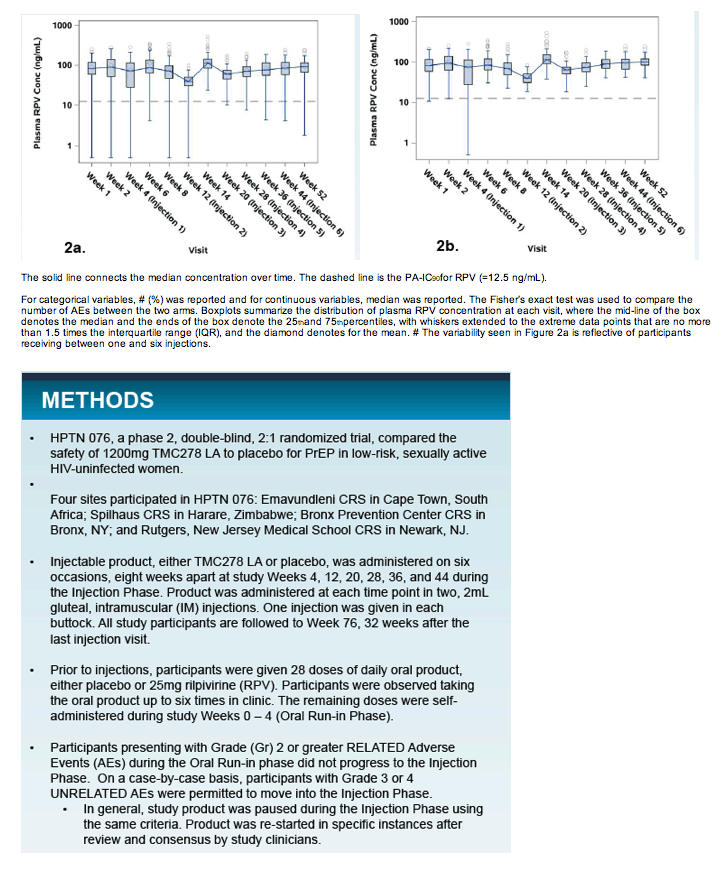 |
 |
 |
| |
Rilpivirine Injected Every 8 Weeks Maintains
Adequate Levels in Women: HPTN 076
|
| |
| |
Conference on Retroviruses and Opportunistic Infections (CROI), February 13-16, 2017, Seattle
Mark Mascolini
Long-acting rilpivirine (RPV LA) injected every 8 weeks in 136 African and US women maintained RPV levels thought to protect from HIV in the HPTN 076 trial [1]. Women largely found the every-2-month shots tolerable and acceptable, and two thirds expressed "definite" interest in trying injectable PrEP.
RPV LA is a preexposure prophylaxis (PrEP) candidate being evaluated in HPTN 076, a phase 2, double-blind trial comparing 1200 mg of the nonnucleoside with placebo in low-risk, sexually active, HIV-negative women [2]. Participants receive 28 doses of daily oral RPV or placebo and proceed to the injection phase if they do not have phase 2 or worse drug-related adverse events. In the injection phase, women receive RPV LA (two 2-mL injections in the gluteal muscles) or placebo shots on study weeks 4, 12, 20, 28, 36, and 44. Injections are interrupted if phase 2 or worse adverse events arise with injections and restart after review and consensus by study clinicians.
The trial enrolled 100 women in Africa and 36 in the United States. Women had a median age of 31 years and a median weight of 75 kg. Most women, 94%, were black.
Fourteen women (11 randomized to RPV LA) withdrew during the oral phase. During the injection phase, 16 women (10 receiving RPV LA) discontinued treatment. Eighty women randomized to RPV LA and 42 to placebo received at least 1 injection; 64 and 34 received all 6 shots. Adverse events caused 6 of 10 discontinuations in the RPV LA arm. Nine women (11%) receiving RPV LA and 4 (10%) receiving placebo had a transient grade 2 or worse adverse event. Three women getting RPV LA injections had grade 3 or 4 injection site reactions. Adverse event rates did not differ significantly between the RPV LA arm and the placebo arm.
The protein-adjusted 90% inhibitory concentration (PA-IC90) of RPV LA is 12.5 ng/mL. Median RPV trough concentration throughout the injection phase stood at 68.2 ng/mL. At week 52 (8 weeks after the last injection), the median trough measured 91.9 ng/mL. Among women receiving all 6 injections, fewer than 2% had RPV concentrations below the PA-IC90 at any time 4 weeks after injections began. The lowest quartile of RPV concentrations always lay above the PA-IC90 through 8 weeks after the last injection.
At study week 44, more than 80% of participants judged injections "easier to use" than daily oral drugs, and three quarters believed injections had the "potential to provide longer-term protection." About 30% of women found the shots painful, and about one third said shots had side effects. At the time of the last injection, 68% of women strongly agreed that they would "definitely use" PrEP injections, and 80% said they would think about using injectable PrEP. At the time of the last shot, only 4% of women "strongly agreed" that they would not use injectable PrEP. Injection acceptability did not differ significantly between the RPV LA arm and the placebo arm.
HPTN 076 investigators conclude that, overall, RPV LA injected every 8 weeks is safe, tolerable, and acceptable and should continue development as a PrEP agent. The long half-life of injectables like RPV and cabotegravir raises concern that drug levels below effective concentrations will persist for months after a final PrEP dose and so pose a risk that resistant HIV will emerge in people who become infected at this point.
References
1. Bekker LG, Li SS, Tolley B, et al. HPTN 076: TMC278 LA safe, tolerable, and acceptable for HIV pre-exposure prophylaxis. Conference on Retroviruses and Opportunistic Infections (CROI), February 13-16, 2017, Seattle. Abstract 421LB.
2. ClinicalTrials.gov. Phase II safety and acceptability of an investigational injectable product, TMC278LA, for pre-exposure prophylaxis (TMC278LA). ClinicalTrials.gov identifier NCT02165202.https://clinicaltrials.gov/ct2/show/NCT02165202
---------------
HPTN 076: TMC278 LA Safe, Tolerable and Acceptable for HIV Pre-Exposure Prophylaxis
Linda-Gail Bekker1, Sue Li2, Elizabeth Tolley3, Mark Marzinke4, Nyaradzo Mgodi5, Jessica Justman6, Shobha Swaminathan7, Adeola Adeyeye8, Jennifer Farrior3, Nirupama Sista3


PARTICIPANT DISPOSITION
⋅A total of 136 (100 African, 36 US) women were enrolled.
⋅During the Oral Run-in Phase, ten women withdrew (8 active arm, 2 placebo arm) and four had product discontinued (3 active arm, 1 placebo arm).
⋅During the Injection Phase, one woman withdrew (placebo arm) and 16 product discontinuations occurred (10 active arm, 6 placebo arm).

INJECTION PHASE: SAFETY DATA
⋅A total of 122 (80 active arm, 42 placebo arm) women received >one injection;
64 active arm and 34 placebo arm participants received all six injections.
⋅Of the 16 product discontinuations during Injection Phase, six (8%) active arm and two (5%) placebo arm were due to AEs
including one placebo arm participant with prolonged QTcinterval.
⋅Transient Gr >2 liver abnormalities occurred in nine (11%) of active arm participants compared with four (10%) in the placebo arm.
⋅Three active arm participants developed Gr >3 injection site reactions compared with none in the placebo arm.
⋅The differences in AEs observed between the two arms were not statistically significant.
INJECTION PHASE:DRUG CONCENTRATION
⋅In participants receiving at least one injection:
⋅The median plasma trough concentration (CTrough) of RPV during the injection phase was 68.2 ng/mL.
⋅The concentration two weeks (C2WK) after the first and second injections (at Weeks 6 and 14) was 85.5 ng/mL and 113 ng/mL, respectively.
⋅At Week 52 (eight weeks after last injection), the CTroughwas 91.9 ng/mL.
⋅In participants receiving all six injections, less than 2% had RPV concentrations below the protein-adjusted 90% inhibitory concentration (PA-IC90) at any given time point after Week 4 when injections began.
FIGURE 2. Rilpivirine Concentration in Active Arm Participants (a) Receiving at Least One Injection (N=80) and (b) Receiving all Six Injections (N=64).*

The solid line connects the median concentration over time. The dashed line is the PA-IC90for RPV (=12.5 ng/mL).
For categorical variables, # (%) was reported and for continuous variables, median was reported. The Fisher’s exact test was used to compare the number of AEs between the two arms. Boxplots summarize the distribution of plasma RPV concentration at each visit, where the mid-line of the box denotes the median and the ends of the box denote the 25thand 75thpercentiles, with whiskers extended to the extreme data points that are no more than 1.5 times the interquartile range (IQR), and the diamond denotes for the mean. # The variability seen in Figure 2a is reflective of participants receiving between one and six injections.
|
| |
|
 |
 |
|
|